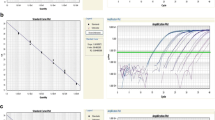Abstract
Intrauterine Parvovirus B19 infections may cause fetal anemia, non-immune hydrops fetalis or abortion. This study focuses on the pathogenic role of Parvovirus B19 in non-immune hydrops fetalis at Hacettepe University, a major reference hospital in Turkey. Twenty-two cases of non-immune hydrops fetalis were retrospectively selected out of a total of 431 hydrops fetalis specimens from the Department of Pathology archieves. Paraffine embedded tissue sections from placental and liver tissues from each case were evaluated by histopathology, immunohistochemistry, nested PCR and commercial quantitative Real-time PCR. Viral DNA was detected in placental tissues by Real-time PCR in 2 cases (2/22, 9.1%) where histopathology also revealed changes suggestive of Parvovirus B19 infection. No significant histopathologic changes were observed for the remaining sections. Nested PCR that targets the VP1 region of the viral genome and immunohistochemistry for viral capsid antigens were negative for all cases. As a result, Parvovirus B19 is identified as the etiologic agent for the development of non-immune hydrops fetalis for 9.1% of the cases in Hacettepe University, Turkey. Real-time PCR is observed to be an effective diagnostic tool for nucleic acid detection from paraffine embedded tissues. Part of this study was presented as a poster at XIIIth International Congress of Virology, San Francisco, USA (Abstract V-572).
Similar content being viewed by others
References
T. Brown, A. Anand, L.D. Ritchie, J.P. Clewley and T.M. Reid: “Intrauterine parvovirus infection associated with hydrops fetalis”, Lancet, (1984), Vol. 2, pp. 1033–1034.
E.D. Heegaard and K.E. Brown: “Human Parvovirus B19.”, Clin. Microbiol. Rev., (2002), Vol. 15, pp. 485–505.
N. Yaegashi, T. Niinuma, H. Chisaka, T. Watanabe, S. Uehara, K. Okamura, S. Mofatt, K. Sugamura and A. Yajima: “The incidence of, and factors leading to, Parvovirus B19 related hydrops fetalis following maternal infection: report of 10 cases and meta-analysis”, J. Infect., Vol. 37, (1998), pp. 28–35.
K.M. Ismail, W.L. Martin, S. Ghosh, M.J. Whittle and M.D. Kilby: “Etiology and outcome of hydrops fetalis”, J. Matern. Fetal. Med., Vol.10, (2001), pp. 175–181.
K. Broliden, T. Tolfvenstram and O. Norbeck: “Clinical aspects of Parvovirus B19 infection”, J. Int. Med., Vol. 260, (2006), pp. 285–304.
L. Skjöldebrand-Sparre, T. Tolfvenstram, N. Papadogiannikis, B. Wahren, K. Broliden and M. Nyman: “Parvovirus B19 infection: association with third-trimester intrauterine fetal death”, Br. J. Obstetr. Gynecol., Vol. 107, (2000), pp. 476–480.
X. Wang, G. Zhang, F. Liu, M. Han, D. Xu and Y. Zang: “Prevalence of human Parvovirus B19 DNA in cardiac tissues of patients with congenital heart diseases indicated by nested PCR and in situ hybridization”, J. Clin. Virol., Vol. 31, (2004), pp. 20–24.
V.L. Katz, M.C. McCoy, J.A. Kuller and W.F. Hansen: “An association between fetal parvovirus B19 infection and fetal anomalies: a report of two cases”, Am. J. Perinatol., Vol. 13, (1996), pp. 43–45.
R.G. Tiessen, A.M. van Elsacker-Niele, C. Vermeij-Keers, D. Oepkes, J. van Roosmalen and M.C. Gorsira: “A fetus with a parvovirus B19 infection and congenital anomalies”, Prenat. Diagn., Vol. 14, (1994), pp. 173–176.
H.T. Weiland, C. Vermey-Keers, M.M. Salimans, G.J. Fleuren, R.A Verwey and M.J. Anderson: “Parvovirus B19 associated with fetal abnormality”, Lancet, Vol. 1, (1987), pp. 682–683.
F. Guidozzi, D. Ballot and A.D. Rothberg: “Human B19 parvovirus infection in an obstetric population. A prospective study determining fetal outcome”, J. Reprod. Med., Vol. 39, (1994), pp. 36–38.
A.L. Morey, J.W. Keeling, H.J. Porter and K.A. Fleming. Clinical and histopathological features of parvovirus B19 infection in the human fetus. Br. J. Obstetr. Gynecol., Vol. 99, (1992), pp. 566–574.
A.L. Morey, H.J. O’Neill, P.V. Coyle and K.A. Fleming: “Immunohistological detection of human parvovirus B19 in formalin-fixed, paraffin-embedded tissues”, J. Pathol., Vol. 166, (1992), pp. 105–108.
D.K. Wright and M.M. Manos: Sample preparation from paraffin-embedded tissues, In: PCR Protocols: A guide to methods and applications, Academic Press, San Diego, 1990.
W. Cao, M. Hashibe, J.Y. Rao, H. Morgenstern and Z.F. Zhang: “Comparison of methods for DNA extraction from paraffin-embedded tissues and buccal cells”, Cancer. Detect. Prev., Vol. 27, (2003), pp. 397–404.
G. Patou and U. Ayliffe: “Evaluation of commercial enzyme linked immunosorbent assay for detection of B19 Parvovirus IgM and IgG”, J.Clin.Pathol., Vol. 44, (1991), pp. 831–834.
S. Braham, J. Gandhi, S. Deard and B. Cohen: “Evaluation of the Roche LightCycler Parvovirus B19 quantification kit for the diagnosis of Parvovirus B19 infections”, J. Clin.Virol., Vol. 31, (2004), pp. 5–10.
T. Tolfvenstram, N. Papadogiannikis, O. Norbeck, K. Petersson and K. Broliden: “Frequency of human Parvovirus B19 infection in intrauterine fetal death”, Lancet, Vol. 357, (2001), pp. 1494–1497.
J.F. Rodis, A.F. Borgida, M. Wilson, J.F. Egan, M.V. Leo, A.O. Odibo and W.A. Campbell: “Management of parvovirus B19 infection in pregnancy and outcome of hydrops: a survey of members of the Society of Perinatal Obstetricians”, Am. J. Obstetr. Gynecol., Vol. 179, (1998), pp.985–988.
T.J. Torok: “Human Parvovirus B19 infections in pregnancy”, Pediatr. Infect. Dis., Vol. 9, (1990), pp. 772–776.
E.P. de Jong, T.R. de Haan, A.C.M. Kroes, M.F.C. Beersma, D. Oepkes and F.J. Walther: “Parvovirus B19 infection in pregnancy”, J.Clin.Virol., Vol. 36, (2006), pp. 1–7.
S.R. Shi, R.J. Cote and C.R. Taylor: “Antigen Retrieval Techniques: Current Perspectives”, J. Histochem. Cytochem., Vol. 49, (2001), pp. 931–937.
P. Wattre, A. Dewilde, D. Subtil, L. Andreoletti and V. Thirion: “A clinical and epidemiological study of human parvovirus B19 in fetal hydrops using PCR southern blot hybridization and chemiluminescence detection”, J. Med. Virol., Vol. 54, (1998), pp. 140–144.
Author information
Authors and Affiliations
About this article
Cite this article
Ergunay, K., Altinok, G., Gurel, B. et al. Identifying the etiologic role of Parvovirus B19 in non-immune hydrops fetalis by histopathology, immunohistochemistry and nucleic acid testing: a retrospective study. cent.eur.j.med 2, 271–279 (2007). https://doi.org/10.2478/s11536-007-0029-z
Received:
Accepted:
Published:
Issue Date:
DOI: https://doi.org/10.2478/s11536-007-0029-z




